Freeze It: Managing Motion in MRI
Freeze It: Managing Motion in MRI
Oral
Oral
Acquisition, Reconstruction & Analysis
Monday, 13 May 2019
| Room 512A-H | 08:15 - 10:15 | Moderators: Claudia Prieto, Tobias Schaeffter |
08:15 |
0066. 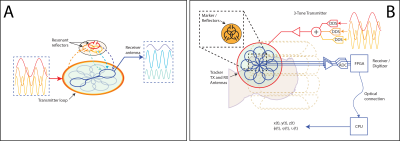 |
Wireless motion tracking with short-wave radiofrequency
Christoph Schildknecht, David Brunner, Thomas Schmid, Jonas Reber, Josip Marjanovic, Klaas Pruessmann
For robust and high-quality brain imaging rigid body motion correction plays an increasingly important role.
We propose a wireless motion tracking method based on short-wave RF signal transmission that does not require a direct line of sight and can penetrate tissue and plastics between detector and marker providing a unprecedented degree of freedom in marker placement and fixation. Single digit micrometer precision during an EPI sequence could be demonstrated even at high tracking bandwidth of 100 Hz with minimal latency and operating independently from the scanner. |
08:27 |
0067 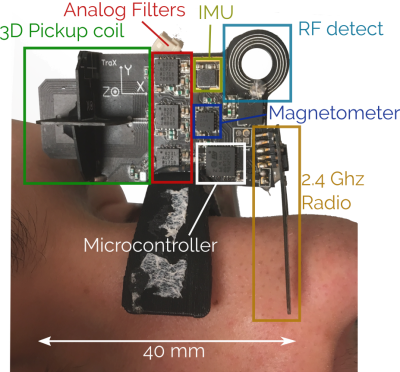 |
Prospective motion correction using a wireless device that combines vector observations of the static magnetic field and the rate of change of the gradient fields. Video Permission Withheld
Adam van Niekerk, Ernesta Meintjes, Andre van der Kouwe
Using external hardware to track patient motion allows for high frequency, accurate prospective motion correction that is robust to changes in coil set-up and subject anatomy. However, this typically comes at the expense of increased hardware complexity, difficulties in marker placement and in some cases cross-calibration. To address some of these challenges, we have developed a small, battery powered marker that uses the three-dimensional gradient spatial encoding, visible through Faraday induction, for vector-based position and orientation estimates. The device enables wireless, calibration-free prospective motion correction that can be used on an ad-hoc basis in an unmodified scanner.
|
08:39 |
0068. 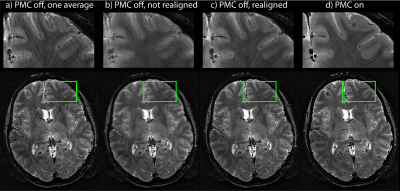 |
Enhanced reliability of NMR marker localization using real-time field tracking
Alexander Aranovitch, Maximilian Haeberlin, Simon Gross, Benjamin Dietrich, Jonas Reber, Thomas Schmid, Klaas Pruessmann
Tracking head mounted NMR markers enables to carry out prospective motion correction for brain MRI. In this work, a NMR marker tracking method that facilitates easy deployment is characterized with respect to tracking reliability in the presence of hardware drift and other imperfections. The method is then applied to a high-resolution in-vivo scan with long scan duration.
|
08:51 |
0069. 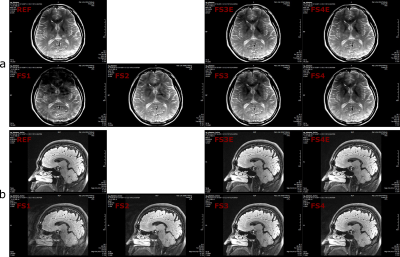 |
Intra echo train correction for constant flip angle Turbo Spin Echo sequence
Xiang Gao, Patrick Hucker, Juergen Hennig, Maxim Zaitsev
Turbo spin echo (TSE) sequence is one of the “workhorses” used in routine clinical applications for MR imaging [1]. However, long scan time and segmented k-space acquisition make it particularly susceptible to
|
09:03 |
0070. 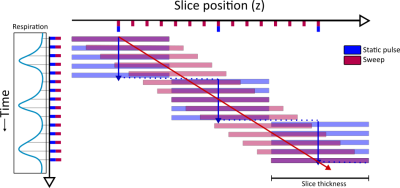 |
Free-breathing placental and fetal MR angiography using continuous stable state acquisition (Sweep)
Laurence Jackson, Anthony Price, Jana Hutter, Alison Ho, Thomas Roberts, Laura McCabe, Maria Deprez, Lucy Chappell, Mary Rutherford, Joseph Hajnal
Major obstetric complications such as pre-eclampsia and intrauterine growth restriction can result from malformations in the circulation of the fetus and placenta. Robust, high resolution in-utero MR angiography has the potential to be a valuable tool in identification and monitoring of these disorders but is hampered by the presence of complex motion, ineffective breath holds and lack of safe contrast agents. Here we present a motion compensated method for visualising the vascular networks in the fetus and placenta using respiration resolved 2D inflow angiography with efficient and dense spatiotemporal sampling and retrospective correction.
|
| 09:15 |
0071. 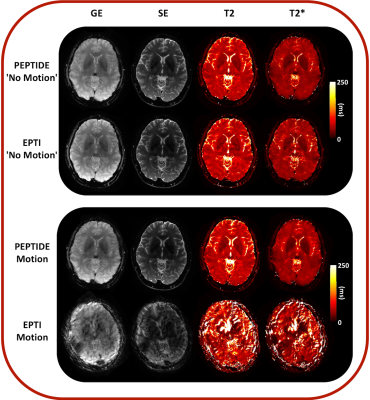 |
Propeller Echo-Planar Time-resolved Imaging with Dynamic Encoding (PEPTIDE)
Merlin Fair, Fuyixue Wang, Zijing Dong, Berkin Bilgic, Timothy Reese, Kawin Setsompop
Echo-Planar Time-resolved Imaging (EPTI) is a recent multi-shot EPI-based approach that allows extremely rapid acquisition of distortion and blurring free multi-contrast imaging and mapping. In this work, a motion robust extension to EPTI, termed PEPTIDE, is presented. Combining Propeller-like rotations into the EPTI sampling strategy, this technique brings significant tolerance to shot-to-shot motion and B0 phase variations, as well as opening up opportunities for further acceleration.
|
| 09:27 |
0072. 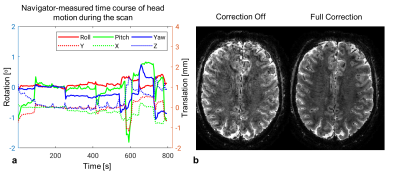 |
Motion-insensitive 3D T2*-weighted MRI using a motion- and B0 field-navigator
Jiaen Liu, Peter van Gelderen, Jacco de Zwart, Jeff Duyn
The ability of T2*-weighted (or susceptibility-weighed) MRI to provide structural and functional information about the brain is affected by B0 field fluctuations associated with head motion, which are inadequately accounted for in current correction approaches. Here, a 3D EPI navigator was developed to measure head motion, map the associated complex B0 field changes and correct their effects in T2*-weighted GRE MRI. Adequate temporal resolution of the navigator was achieved by implementing 2D parallel imaging with controlled aliasing. A fast reconstruction strategy is proposed to retrospectively correct the motion artifacts, overcoming limitations of prospective B0 corrections inadequately dealing with the spatially complex B0 changes.
|
09:39 |
0073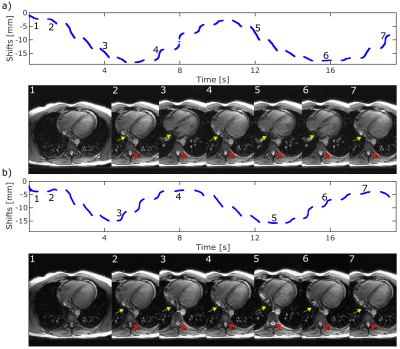 |
Pilot tone-based prospective respiratory motion correction for 2D cine cardiac MRI Video Permission Withheld
Juliane Ludwig, Peter Speier, Frank Seifert, Tobias Schaeffter, Christoph Kolbitsch
Respiratory motion during data acquisition can introduce strong motion artefacts in 2D cine cardiac MR images. The commonly used breathhold method minimizes these artefacts, but also limits achievable image resolution and requires patient cooperation. Here we present a prospective motion correction technique using RF pilot tone signals with high temporal resolution. A calibration scan was carried out to convert signal intensity changes of the pilot tone to displacements of the heart due to breathing. The proposed approach was evaluated in four healthy volunteers and allowed for free-breathing 2D cine MR with high image quality.
|
09:51 |
0074. 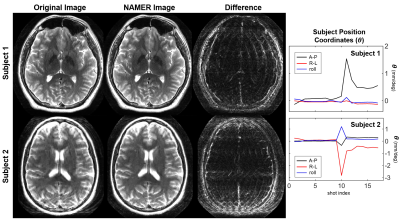 |
Network Accelerated Motion Estimation and Reduction (NAMER): Accelerating forward model based retrospective motion correction using a convolutional neural network
Melissa Haskell, Stephen Cauley, Berkin Bilgic, Julian Hossbach, Josef Pfeuffer, Kawin Setsompop, Lawrence Wald
Retrospective motion correction techniques have the potential to improve clinical imaging without altering the workflow or acquisition sequence. Yet, they suffer from long reconstruction times and poor conditioning. To address these problems, we developed a Network Accelerated Motion Estimation and Reduction method (NAMER) within a data-consistency based forward model approach to motion parameter estimation. The neural net accelerates convergence up to 15-fold as well as improving final image quality. The ML+MR physics motion correction method combines the speedup provided by fast convolutional neural networks with the robustness of a forward model-based data-consistency reconstruction.
|
10:03 |
0075. 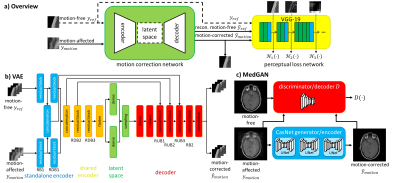 |
Retrospective motion correction using deep learning
Thomas Kuestner, Bin Yang, Fritz Schick, Sergios Gatidis, Karim Armanious
Motion is the main extrinsic source for imaging artifacts which can strongly deteriorate image quality and thus impair diagnostic accuracy. Numerous motion correction strategies have been proposed to mitigate or capture the artifacts. These methods have in common that they need to be applied during the actual measurement procedure with already a-priori knowledge about the expected motion type and appearance. We propose the usage of deep neural networks to perform retrospective motion correction in a reference-free setting, i.e. not requiring any a-priori motion information. Feasibility and influences of motion type and origin as well as optimal architecture are investigated.
|
 Back to Program-at-a-Glance |
Back to Program-at-a-Glance |  Back to Top
Back to Top